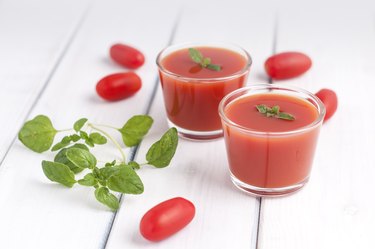
During small bowel obstruction, the normal flow of the contents of the digestive system are completely or partially blocked. Most blockages resolve once the small bowel has had time to rest. A nasogastric tube may be inserted through the nose and into the stomach to remove fluid. During this time, eating and drinking are prohibited, and fluids are administered intravenously. When the blockage is cleared, you can begin to eat an intestinal blockage diet consisting of easily digested foods.
Liquid and Full Liquid Diet
Video of the Day
Once you're able to have a bowel movement, the nasogastric tube will be removed to allow you to eat and drink. You will likely first be provided sips of clear fluids to see if you can tolerate it. If you can, you will move on to a full liquid bowel obstruction diet and remain on that for a day or two. A liquid diet will put less pressure on the bowel so it can continue healing while still giving you crucial nutrition.
Video of the Day
On a full liquid diet, you can continue to drink clear fluids, and you can add:
- Fruit and vegetable juices and nectars
- Milk products, including cow's milk, rice, soy and almond milks; buttermilk; milkshakes; frozen yogurt; pudding; smooth ice cream; and yogurt without fruit
- Cooked, refined cereals, including farina, cream of rice and cream of wheat
- Butter and oil
- Gelatin and fruit Popsicles without fruit, sugar and honey
- Broths, strained tomato soup and strained cream soups
- Formulated nutritional drinks.
- Tea and coffee
Avoid anything that requires chewing and anything with fiber. Fiber is hard to digest and will put too much stress on your digestive system. Although the main goal now is to heal your bowel, which sometimes means eating anything your system will tolerate, it's a good idea to stick to healthier liquid options such as fruit and vegetable juices; unsweetened milk products; formulated nutritional drinks; refined cereals; and low-sodium nutrient-rich strained soups.
Full Liquid Sample Meal Plan
You will probably still be in the hospital while you are on the full liquid diet, so your meals will be designed for you. A typical daily meal plan might include a variety of low-fiber foods:
- Breakfast: Fruit juice, coffee or tea, cream of wheat with milk, pureed pears
- Lunch: Strained tomato soup, milk, fruit juice, Popsicle
- Snack: Nutritional drink
- Dinner: Strained cream of vegetable soup, pureed peaches, Popsicle
Read more: List of Foods High in Soluble Fiber
Low-Fiber Diet
If you tolerate the full liquid diet well, you will be able to transition to solid foods. However, you should still continue to eat easily digested foods that are low in fiber. Typically a low-fiber diet contains less than 10 to 15 grams of fiber per day. Your doctor will tell you to what extent you need to limit your fiber and how long you will remain on this diet.
A few tips make it easier to follow this diet:
- Read labels to choose foods low in fiber.
- Cook your foods well.
- Chew your foods completely before swallowing.
- Avoid any food that is fibrous or stringy, including gristly meat.
- If foods are not well-tolerated, try pureeing them.
There is a long list of foods to avoid on a low-fiber diet, and the main categories include:
- Bran (wheat, rice and corn).
- Fruit and vegetable skins.
- Nuts and seeds.
- Whole-grain foods.
These foods are rich in insoluble fiber, the type of fiber that moves through your digestive system relatively intact and provides bulk to your stool. While that's healthy in your regular diet, it puts too much strain on your bowel while you are recovering.
Low-Fiber Bowel Obstruction Diet Sample Foods
As long as you stick within the main guidelines for foods not to eat, you can eat anything your digestive system will tolerate.
Breakfast:
- White toast or English muffin with butter
- Scrambled egg
- Peach and banana smoothie
Lunch:
- Chicken breast
- Tomato soup
- Canned fruit without added sugar
Dinner:
- Well-cooked white fish
- Sweet potato
- Well-cooked zucchini, carrots and cauliflower
Stick to the low-fiber diet until you are healed and the doctor gives you the go-ahead to add more fiber-rich foods into your diet. Ultimately, you want to get the daily recommended amount of fiber, which is 38 grams for men and 25 grams for women. Eating a diet rich in fiber can help prevent another bowel obstruction in the future.
Is this an emergency? If you are experiencing serious medical symptoms, please see the National Library of Medicine’s list of signs you need emergency medical attention or call 911.